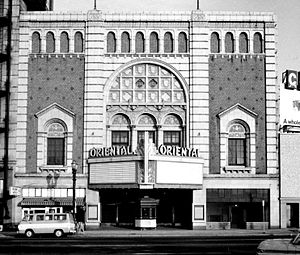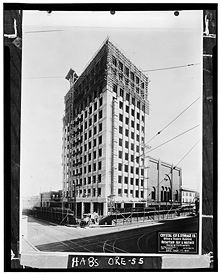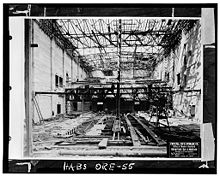- Oriental Theatre (Portland)
-
Coordinates: 45°31′01″N 122°39′39″W / 45.516815°N 122.660753°W
Oriental Theatre 
Oriental Theatre main entrance, November 1969Address 828 SE Grand City Portland, Oregon Country United States Architect Lee Arden Thomas, Albert Mercier Capacity 2,038 Opened December 31, 1927 Demolished 1970 Current use Demolished (parking lot) The Oriental Theatre was a movie theater located at 828 SE Grand Street in the East Portland commercial district of Portland, Oregon. Built in 1927 the Oriental was a 2,038 seat movie palace designed by Lee Arden Thomas and Albert Mercier.[1][2][3] The building's exterior was in the Italian Renaissance style. The interior had an "almost surreal appearance" created by interior designer Adrien Alex Voisin.[2] It was built by George Warren Weatherly. Demolished in 1970, the theater was located next to the Weatherly Building, which remains standing.[1]
Contents
Architecture and construction
Walter Eugene Tebbetts is listed as "the promoter who persuaded Weatherly to build a theatre," and was the first lessee and manager of the theater.[1] Tebbetts previously managed the Italian Opera House in Chicago before arriving in Portland around 1909, after which he ran the Empire Theatre and a series of movie theaters, including the Hollywood Theatre.[1] Tebbetts presumably visited the East Indies while travelling abroad in the late 1920s, and wanted a theatre designed to look like an East Indian temple.[1]
Thomas and Mercier were chosen for their "association with East Portland" and their previous theatre design experience with the Bagdad Theater in Portland, McDonald Theatre in Eugene, and the Egyptian Theatre in Coos Bay.[1] They moved into the Weatherly building upon its completion.[1] The building cost was "variously reported between $300,000 and $500,000."[1] The general contractor of the building was Robertson, Hay, and Wallace.[1] While under construction, the project was called the "Crystal Ice & Storage Co. Office & Theatre Building."[1]
Groundbreaking began on March 21, 1927, and was completed by December 31, 1927.[1]
The building was designed and built at the same time as the neighboring Weatherly Building. The exterior design matched the Weatherly Building, and heat was supplied from it.[1]
Design and appointment
The Oriental utilized Asian influences from India, Indochina, and China and included "columns on each side of the screen", said to be based on the Temple of Angkor Wat in Cambodia. There was a huge stylized face over the proscenium arch , "which had a wide open mouth baring fangs and eyes lit by red lightbulbs that would glow demonically before a show began" and "on the side walls and over the arch were life-sized plaster elephants, as well as apes, fishes, and mythological creatures, seemingly ready to pounce off the wall."[2]
The lobby and mezzanine were decorated with Hindu deities and "the main staircase leading to the balcony was flanked by a pair of huge dragons," while the auditorium was topped by a vast dome, lit indirectly by 2400 light bulbs, as well as a 2,000 pounds (910 kg) "tree-sized Far Eastern style chandelier"[2] including 3000 light bulbs in seven colors, costing $7000.[1] The asbestos drop curtain was blue with gold fringes and tassels and included a hand-painted royal procession scene, with "towering snow-capped mountains in the background [and] a misty blue apparition of the seated Buddha."[1] The Historic American Building Survey noted the "remarkably early extensive use of neon lighting" in the sign and sheet-metal marquee.[1]
Music was provided by a $50,000 Wurlitzer 235 Special 3-manual 13-rank organ on an ascending platform, a full orchestra pit on another ascending platform.[1][2] The Wurlitzer was panned for being "never clearly audible from many of the nearly 5000 seats underneath the balcony", and for being difficult to hear for the organist.[1] Knabe concert grand pianos were used in the orchestra and on stage, as well as a Knabe-Ampico grand player piano in the smoking room.[1] The spacious stage was "large enough to accommodate the biggest stage shows of the day."[1][2] There were also "luxurious lounges, smoking rooms and even a nursery in its basement".[2] The nursery was called the "Kiddie Circus".[1] It changed to a movies-only format by the 1940s "and lost its towering vertical marquee in favor of a more modest marquee not long afterwards", but remained a city showplace for years, and was used in the mid-1960s for concerts on its "mighty Wurlitzer".[2]
Theatre operation
The grand opening included "An Atmospheric Prologue", and silent films The Girl from Everywhere and The Moon of Israel.[1] Portland mayor George Luis Baker dedicated the theatre, proclaiming he had "seen more expensive houses, but never a more beautiful one."[4] Shows initially cost 25 cents for matinees, 35 cents for evenings.[1][4]
The theatre upgraded to a sound system for talking pictures by 1930, perhaps earlier, as it won a bronze award for acoustics and sound systems from Will H. Hays's Exhibitors Herald-World that year. The Oriental advertised "WHERE THE SOUND IS BETTER" on their marquee in neon after winning the award.[1]
Aside from independent operators, the theatre was leased to Evergreen Theatres in 1935, the Rainier Theatre Corporation/Fox-West Coast Theatre Company by 1940. While it "had a history of proving burdensome to independent operators", the theatre was leased to the City of Portland for 2.5 years in 1965. During this lease, Isaac Stern appeared with the Portland Symphony Orchestra on February 28, 1966,.[1] It returned to showing films after the lease expired.[1]
Fate
 Weatherly building and Oriental Theatre on December 31, 1927, before brick and terra cotta facade were added
Weatherly building and Oriental Theatre on December 31, 1927, before brick and terra cotta facade were added
Lobbying to save the theatre began by at least 1959, and after Clayton Weatherly died in May 1969, the heirs decided to sell, despite a "premium lease" offer that was made.[1]
Everything inside the theatre was auctioned off, with the Wurlitzer going to the Organ Grinder Restaurant, who later upgraded their console, sending the Oriental Theatre organ console to Uncle Milt's Pizza on Grand Blvd in Vancouver, Washington. Uncle Milt's Pizza closed in 1999, the organ-facaded building being sold to Rite Aid,[2][5][6] who abandoned plans to build a drugstore there. The location is now a Lord's Gym Christian "sports outreach center".[7][8] Some of the plasterwork went to the Robin Hood Theatre in Sherwood, Oregon, which was being rebuilt and was subsequently renamed the Sherwood Oriental Theatre.[1]
The Oriental Theatre was demolished in February or April 1970, making room for parking at the Weatherly Building.[1][4] It was lamented as an "amazing old theater was tragically demolished to make way for another parking lot, an irreplaceable loss for the city of Portland".[2] As of 2009, the space formerly occupied by the Oriental is still a parking lot.
See also
References
- ^ a b c d e f g h i j k l m n o p q r s t u v w x y z aa ab Potter, Elisabeth Walton; Elisabeth Walton Potter (State Park Historian, Salem, Oregon, January 1970), Lucy Pope Wheeler (Writer/Editor, HABS, 1976), Denys Peter Myers (Architectural Historian, HABS, 1979) (1979). Historic American Buildings Survey: The Oriental Theatre, HABS No. Ore-55.
- ^ a b c d e f g h i j Bryan Krefft Oriental Theater (Portland)
- ^ Constance M. Greiff Lost America: from the Mississippi to the Pacific Page 186; 1972 243 pages
- ^ a b c Lacher, Gary; Steve Stone. Theatres of Portland (Images of America). Arcadia Publishing. ISBN 0738571474.
- ^ "PSTOS - Organ Grinder Restaurant, Portland Oregon". Puget Sound Theatre Organ Society. http://www.pstos.org/instruments/or/portland/organ-grinder.htm. Retrieved 2009-12-22.
- ^ "PSTOS - Uncle Milt's Pizza Co, Vancouver Washington". Puget Sound Theatre Organ Society. http://www.pstos.org/instruments/wa/vancouver/milts.htm. Retrieved 2009-12-22.
- ^ Lord's Gym, Location - Vancouver, WA
- ^ Lord's Gym (Former Uncle Milt's Pizza) (Vancouver), Wikimapia
External links
- Oriental Theatre, Portland, Oregon information and pictures on the Puget Sound Theatre Organ Society website
- Portland theaters website with old photos (bottom of page)
Categories:- Buildings and structures demolished in 1970
- Theatres in Portland, Oregon
- 1927 architecture
- Demolished theatres of the United States
Wikimedia Foundation. 2010.









